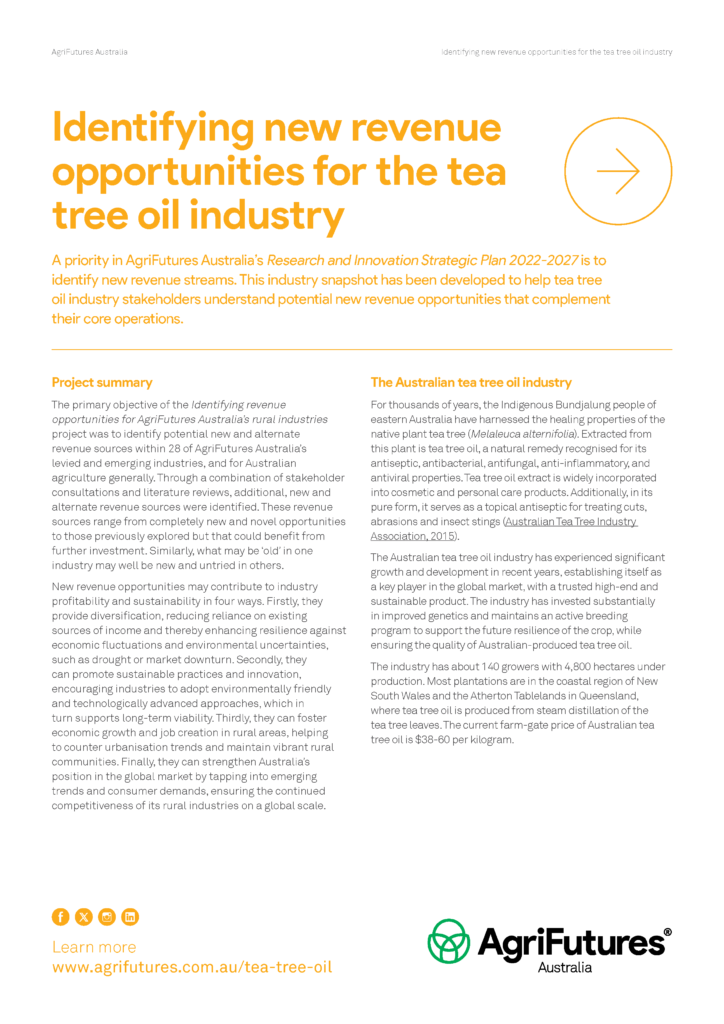Virucidal effects of tea tree oil
Consumer demand for natural products such as Australian tea tree oil (Melaleuca alternifolia) is driving researchers to investigate their efficacy against respiratory viruses in humans...
 TEA TREE OIL
TEA TREE OIL 
2 pages
Published: 11 Oct 2024
Author(s): AgriFutures Australia
Download report PDF
DownloadThe primary objective of the Identifying revenue opportunities for AgriFutures Australia’s rural industries project was to identify potential new and alternate revenue sources within 28 of AgriFutures Australia’s levied and emerging industries, and for Australian agriculture generally. Through a combination of stakeholder consultations and literature reviews, additional, new and alternate revenue sources were identified. These revenue sources range from completely new and novel opportunities to those previously explored but that could benefit from further investment. Similarly, what may be ‘old’ in one industry may well be new and untried in others.
New revenue opportunities may contribute to industry profitability and sustainability in four ways. Firstly, they provide diversification, reducing reliance on existing sources of income and thereby enhancing resilience against economic fluctuations and environmental uncertainties, such as drought or market downturn. Secondly, they can promote sustainable practices and innovation, encouraging industries to adopt environmentally friendly and technologically advanced approaches, which in turn supports long-term viability. Thirdly, they can foster economic growth and job creation in rural areas, helping to counter urbanisation trends and maintain vibrant rural communities. Finally, they can strengthen Australia’s position in the global market by tapping into emerging trends and consumer demands, ensuring the continued competitiveness of its rural industries on a global scale.
Industry-specific challenges
Specific insights relating to the Australian tea tree oil industry include:
1. Increasing consumer regulation could have significant impacts on future market access, particularly for premium markets in Europe and North America.
2. Many global manufacturers bought large quantities of tea tree oil during the COVID-19 pandemic, recognising the ingredient as a potential effective and safe natural disinfectant. Manufacturers around the world are now right-sizing stocks by working through their existing supply.
3. Production and productivity challenges arising from flooding in crucial production areas have affected the ability of plantations to recover and hindered the establishment of new plantations.
Industry-specific opportunities
Specific opportunities relating to the Australian tea tree oil industry include:
1. Continuing to invest in an industry-led plant breeding program that produces varieties that exhibit resistance to leaf drop, stem dieback and frost damage. Addressing other traits such as increased yield, breeding a ‘greener product’ and investigating the potential to breed a lower-methyl eugenol variety of Melaleuca alternifolia could enhance the value of the industry and give Australian producers a global competitive edge.
2. Participating in carbon sequestration and biodiversity markets – trees are cut to their roots when harvested, thus the industry presents an intriguing scenario when considering its potential for monetising carbon credits. Further research is needed to better understand the carbon sequestration potential of tea tree roots and establish industry baselines.
3. Exploring opportunities to diversify product offerings beyond cosmetics and personal care, targeting industries with fewer regulatory barriers. Tea tree oil has a range of applications in various sectors, including aromatherapy, agriculture, medical/pharmaceutical, homecare and pet care.